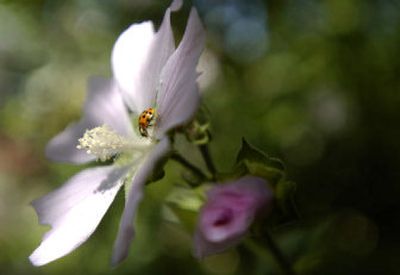Heat brings spider mites

It’s time to start watching for the next pest invasion: With the onset of hot dry weather in the last couple of weeks, tiny spider mites will soon be out in full force to attack unsuspecting trees and plants.
What spider mites lack in size, they make up for in the damage they can cause to hundreds of ornamental plants.
Spider mites are not a true spider although they are related. The reference to “spider” comes from the eight legs adult mites have. They are tiny, only about 1/50 inch long when mature. That’s smaller than a poppy seed. Their presence often goes unnoticed until damage on the plant becomes visible.
Four types of spider mites commonly found in the Northwest. Of that number, the twospotted spider mite is the most common of the pests on landscape and garden plants.
The mites range in color from light yellow or green to dark green or brown. Both male and females have a characteristic two dark spots visible on their abdomen. They are usually found on the underside of leaves or needles which makes them even harder to spot. The mites create a network of fine, silky webs that cover the underside of the foliage. The webs are a transportation network which allows the mite to move around, rather than a fly-trapping device.
Females use the webbing to lay relatively large eggs. Larvae hatch from the eggs in three to 15 days (depending on temperature) and can mature into adults in as few as five days.
Spider mites can infest hundreds of plants, including tree fruits, small fruits, evergreens, shade trees, vegetables and flowers. The twospotted mite alone has been recorded on nearly 300 different plants. Dense conifers like Alberta spruce are a favorite.
Usually, the first sign of a mite invasion is the appearance of chloroic and stippled leaves or needles with a bronzed cast. Spider mites feed by puncturing individual plant cells on the underside of the leaf and sucking out the leaf cell contents; including the chlorophyll that gives the leaf its green color. Without the color the leaf or needle appears whitish or bronze. One mite can puncture upwards of 100 cells an hour. Multiply that by a few thousand mites on one plant and it’s easy to see how much damage they can do very quickly.
Look on the undersides of leaves and needles for the tell-tale web or tiny red or brown dots. Check any plant that seems to be dying back in patches especially on new growth.
Mite damage increases markedly in the hot, dry, dusty weather we usually experience in July and August. Researchers have found that heat and dryness dehydrate the mites and in response, they go looking for more moisture to replenish they bodies.
For an average infestation, or as preventive medicine, getting a jump on the pests is as easy as picking up your hose and spraying your plants with a hard stream of water to knock the mites off the leaves.
The watering also washes off dust and adds some humidity to the leaf surfaces, all which reduce the effects of the heat and dryness that increase mite activity. Be sure to spray the underside of leaves and into tight bundles of foliage.
Several predatory mites and insects – including ladybugs – that feed on spider mites. Given half a chance, they usually do a pretty good job of keeping them in check.Scientists realized this when they noticed that spider mite populations tended to explode after the application of a broad spectrum insecticide. It turns out that not only did the spray kill the mites, but also all of the predatory insects. When the surviving mites began to return, there were no predators to keep them in check.
In some cases, however, where there is a severe infestation, the application of an insecticidal soap may be needed. Apply it only where it is needed to minimize contact with the predatory insects.